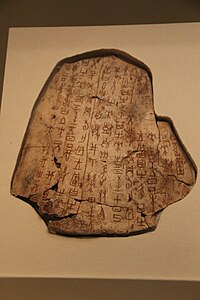| Religion of the Shang dynasty | |
|---|---|
 An ox scapula inscribed with the results of divination[1] | |
| Type | Polytheistic religion |
| Theology | |
| Region | Yellow River valley |
| Language | Old Chinese |
The state religion of the Shang dynasty (c. 1600 – c. 1046 BC) involved trained practitioners communicating with deified beings, including deceased ancestors and supernatural gods.[3] Primary methods of spiritual veneration were written divinations on oracle bones and sacrifice of living beings. The Shang dynasty also had large-scale constructions of tombs,[4] which reflects their belief in the afterlife, along with sacred places. Numerous Shang vessels, as well as oracle bones, have been excavated in the kingdom's capital Yin.[5][6] They reveal a large number of honoured deities, most of which came from the Shang's extensive observations of the surrounding world. Headed by the god Dì, the deities formed a pantheon.
The Shang kingdom's religion, accounting for a large portion of court life, played an important role to its adherents. The deities worshipped received various honorary ceremonies. The Shang astronomers created a sophisticated calendar system based on astronomical observations.[7] Complying with the calendar, diviners and sacrificial practitioners conducted liturgical rituals aimed at the gods. Regional practice became existent, as personal estates maintained independent practitioners. Generally, they all worshipped the same deities for common purposes. Mass offerings to gods, formalized over time, were held for divine support and welfare of the late Shang state.
The Shang religion originated in the Yellow River valley, heartland of the Chinese civilization from 1600 to 1046 BC,[a] and was the first thoroughly documented Chinese religion. Although its writing script is much older, the first inscribed oracle bones of this religion date from c. 1250 BC,[11][12] during the reign of Wu Ding (c. 1250 – c. 1200 BC),[13][14][15][16] and over 1000 years before the end of ancient China in 221 BC. Throughout over two centuries, the dynasty increased its cultural influence and experienced cultural exchanges by means of war. After 1046 BC, the Zhou dynasty, which replaced the Shang,[9][10] gradually assimilated elements of Dì into its governing beliefs.[17][18] Over the following millennia, many elements of the ancient religion were reflected in the later religious system of the Zhou dynasty, as well as the systems of imperial China (221 BC – 1912 AD). Shàngdì remains an important figure in Chinese culture, and the calendar originally used for religion is now important in traditional events of China and influenced countries.
- ^ Chen, Kuang Yu; Song, Zhenhao; Liu, Yuan; Anderson, Matthew (2020), Reading of Shāng Inscriptions, Springer, Shanghai People's Publishing House, pp. 227–230, ISBN 978-981-15-6213-6
- ^ Chang (1983)
- ^ Keightley (1978a).
- ^ Mizoguchi & Uchida (2018).
- ^ Bai (2002).
- ^ Wilkinson (2022).
- ^ Smith (2011a).
- ^ Lee (2002), p. 28.
- ^ a b Keightley (1999).
- ^ a b Pankenier (1981–1982).
- ^ Boltz, William G. (February 1986). "Early Chinese Writing, World Archaeology". Early Writing Systems. 17 (3): 420–436.
- ^ Emily Mark (2016). "Oracle Bones". World History Encyclopedia.
The oracle bones found thus far date from c. 1250-1046 BCE and give all kinds of important information about the Shang Dynasty.
- ^ Takashima (2012).
- ^ Liu et al. (2021).
- ^ Imperial China: The Definitive Visual History. New York: DK and Encyclopedia of China Publishing House. 2020. ISBN 978-0-7440-2047-2.
- ^ Tanner, Harold M. (2010) [2009]. China: A History. Hackett Publishing Company. p. 40. ISBN 9780872209169.
- ^ Stefon (2010).
- ^ Eno (2008).
Cite error: There are <ref group=lower-alpha> tags or {{efn}} templates on this page, but the references will not show without a {{reflist|group=lower-alpha}} template or {{notelist}} template (see the help page).
© MMXXIII Rich X Search. We shall prevail. All rights reserved. Rich X Search
